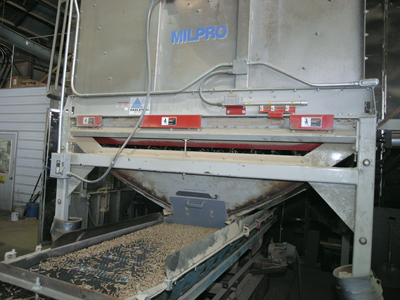
Pellets Rule
May 20, 2009
By
Scott Jamieson
Canada already has a strong pellet manufacturing sector, with plants across the nation producing some two million tonnes per year, and more on the way. Still, with strong incentives to use renewable energy overseas
Canada already has a strong pellet manufacturing sector, with plants across the nation producing some two million tonnes per year, and more on the way. Still, with strong incentives to use renewable energy overseas, the lion’s share of those pellets, even from the main manufacturing zone in the BC Interior, are shipped all the way to Europe to be used.
 |
|
| Developing local markets may also change the scale of operations in Canada, allowing smaller players like flooring plants or remanufacturers to get into the pellet business to diversify revenue, like this Virginia flooring plant’s new line above.
|
In a presentation at the Wood Pellet Association of Canada’s (WPAC) annual meeting in Prince George this past June, research director Staffan Melin reminded the audience that Canada remains a bulk producer and shipper. With 25 plants in Canada in 2008 producing an average of 56,000 tonnes/year, we compare to an average plant size of 17,000 tonnes in the US and 16,000 tonnes in the EU.
The European market has been a boon to Canada’s growing pellet industry, and will likely continue to be, as Doug Bradley, president of both Climate Change Solutions and Canadian Bioenergy Association (CANBIO) explains. Yet things may be about to change.
“Export markets have driven the building of pellet plants in Canada until now, and those markets will continue to drive the financing and building of new ones. Yet we expect that gradually over time the domestic market will grow, and the export volumes will shrink.”
That will likely be a good thing too, for if nothing else the current lumber markets should teach Canadian forestry suppliers the importance of market diversification. Moreover, as shipping costs rise alongside diesel costs, it’ll be good to have options if and when the European equation no longer makes sense.
Bradley feels all the indicators are pointing in this direction. For starters, we have lots of biomass, and an increasing political will to use it. “There are 12 million tonnes of old hog fuel that have been lying around for 30 years, and that’s just a start. Four of our forestry provinces – BC, Ontario, Quebec and New Brunswick – are now adamant about using harvest slash for something other than piling and burning it at roadside. It’s being wasted now, so it makes sense.”
Also, Canada is rapidly moving to a carbon credit system, one of the key ingredients behind the development of Europe’s blazing biomass sector. While provinces are making tentative steps, some better than others, Bradley confidently predicts that “we will have a national carbon trading system here within two years.”
 |
|
| John Swann, president of the Wood Pellet Association of Canada. “We’d stay home in a heartbeat if we could,” he says in explaining Go Pellets, a new program to promote domestic pellet use.
|
Pellet Prince
Few would be happier than John Swann, WPAC president and long-time pellet producer himself. “We’d stay home in a heartbeat if we could. Shipping bulk for export like we do carries a heavy capital investment and extra costs and risks to manage. You’ve got to manage the rail service, charter the vessels, and deal with the associated risks. I could have retired on all the dead freight and cars I’ve seen over the years,” he adds with a laugh.
Currently Swann says the European market accounts for 50 to 60% of Canada’s growing pellet production, the US for 30 to 40%, and then small domestic and some Japanese shipments the rest. Yet he too is optimistic that the domestic tide is turning.
“It’s coming. Fossil fuel alternatives are expensive and look to at least stay that way. It also seems that access to the environment for fossil fuel producers – in the form of GHG emissions – will no longer be free. We’re confident that change is happening. We can already save homeowners half of their heating bill, for instance.”
Swann sees big potential for industrial users like greenhouses, which have seen their energy bills skyrocket of late. They would welcome a change to take more control over this cost centre, assuming the payback was in the 1.5 to 2 year range and no longer. Dave Harrison, long-time editor of Canadian Greenhouse magazine in Simcoe, ON, confirms that interest in biomass and bioenergy alternatives has accelerated over the past five years, and has really taken off over the past 18 months in the face of record energy costs.
“I’d have to say that labour is still the number one cost in our industry at around 40% of the total cost of doing business, but energy isn’t far behind anymore. There’s also a sense that natural gas is a very volatile cost. We’ve seen a lot of very big projects to convert to biomass – pellets in areas with ready supply, or wood construction waste in other areas. Growers that have embraced it have been very happy, especially those who have managed long-term contracts for the wood supply.”
He adds that BC is way out in front, thanks to the more readily available supply, but that growers in other areas, such as the Leamington area in southern Ontario, which boasts the largest concentration of greenhouses in North America, are looking at or have already invested in biomass options too.
Then there’s the home heating front, a big market in Europe. Swann feels we’ll need to take a page out of Europe’s book first if we want to make headway with busy Canadian homeowners.
“We need to make it convenient for the homeowner, and we need to give them confidence in the long-term supply and distribution. In Europe you see some big players getting involved. When Shell says it will supply your pellets, that’s different.”
The delivery and furnace systems are available (see World Bioenergy report on page 28), and in fact some northeastern US oil distribution companies are already talking about offering the pellet alternative. Also, new start up Maine Energy Systems is selling complete, automated pellet heating systems to homeowners in that state, including bulk delivery and one-touch operation. Swann is hoping biomass home heating will soon move from talk to walk in Canada and other states as well.
 |
|
| Doug Bradley, CANBIO and Climate Change Solutions president says export markets will continue to drive the pellet sector.
|
Active Aid
Still, neither he nor Bradley is willing to just sit and wait for it to happen. For starters, CANBIO is playing honest broker between technology suppliers and potential biomass users to get things rolling. Aside from the organization’s recent tour through Sweden and World Bioenergy this past May, its annual conference this October will include a trade show featuring bioenergy technology experts from Finland, Austria and Canada. The organizers are trying to build bridges between this knowledge and technology pool and the growing number of Canadian community leaders that are looking at biomass as a solution to their energy and local economy woes.
“There were several community leaders from Quebec and Ontario at the recent World Bioenergy Conference in Sweden, looking for answers to outrageously high local heating from oil or naturals gas. The need is there. So we’re talking about pellet burners and boilers, heating systems, etc… from suppliers with experience who before they even meet here with the community representatives will know the circumstances and needs of those communities. We will work with them to be able to offer tailored solutions to the community members we are inviting to our conference. Instead of theory, it will be actual solutions to real community situations.”
There are a slew of options for such communities, from gasification to simply burning the biomass in a boiler. Yet Bradley feels that in many cases communities will be best served by pellet technology. The technology to make pellets is readily available in Canada, and the end result is a uniform, dependable fuel source for local plants to use.
Swann and Bradley’s organizations are also working together on a brand new initiative called Go Pellets. The program’s strategy will be hammered out this summer and unveiled this fall, but its general objective is to help develop a domestic market for pellets, as Swann explains.
“I see its key role being to identify and promote domestic market opportunities, and work with the various agencies with an interest in moving away from fossil fuels to promote pellets as a real alternative, and to accelerate their development. We can help get the ball rolling, as a conduit between all interested parties. For example, in Europe you see programs that pay 25 to 30% of the conversion costs to move from fossil fuels. There’s support of the infrastructure. That sort of thing.”
There are Canadian precedents of course, like programs by Hydro Quebec to subsidize conversions from oil heating to “dual-energy heating”, a mix of hydro and oil that maximized hydro use in warmer temperatures when demand was down, and switched to oil when the mercury fell below -15 C.
When the alternative is to transport pellets some 7,000 km to burn in Belgium or Denmark, while we burn increasingly precious oil, it all makes good business, and environmental sense.
Print this page